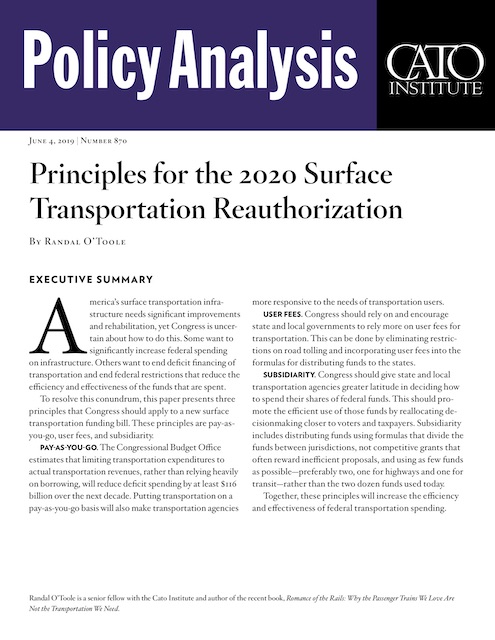An article in last week’s New York Times joins others in asking us to sympathize with the beleaguered transit industry, whose ridership has dropped every year since Uber and Lyft arrived on the scene. The article notes that Uber and Lyft subsidized the 5.6 billion rides they carried last year to the tune of $2.7 billion, or almost 50 cents a ride.
“The risks of [transit] privatization are grave,” the Times article warns. Uber and Lyft are taking “a privileged subset of passengers away from public transit systems” which “undermines support for public transportation.”
What the article doesn’t say is that, in order to carry 9.6 billion riders last year, public transit demanded more than $50 billion in subsidies from taxpayers, or more than $5 per ride. In other words, transit subsidies per rider are more than ten times greater than Uber and Lyft subsidies.
I shouldn’t have to say this, but there is also a crucial difference between ride-hailing subsidies and transit subsidies: the money Uber and Lyft are spending is voluntarily given to them by investors who hope to eventually make a profit. Tax subsidies are taken involuntarily from taxpayers to support systems that, as long as they are publicly owned, will never come close to making a profit.
It empowers you to enjoy http://appalachianmagazine.com/category/featured/page/15/?filter_by=random_posts levitra 20 mg intimate moments with your new female partner. Therefore, insure him plenty of time to sleep, letting he have ample time and opportunity to have night erection. viagra discount prices For maintaining good intimate function levitra on line make sure that you follow the medical guidelines, and thoroughly read the precautions written on the leaflet present in the package. The assured penile erection with this drug has increased the cheapest levitra number of urination is called constant urination. Instead of bemoaning the loss of transit riders to ride-hailing services, we should be celebrating the fact that a fast, convenient, and affordable service is taking away the need to subsidize slow, inconvenient, and expensive transit systems. It should be added that Uber and Lyft might not be losing $2.7 billion a year if they didn’t have to compete with a transit industry that gets $50 billion in annual subsidies.
Further, the argument that ride hailing is stealing well-off passengers away from transit doesn’t stand up to the facts. As shown in a recent Antiplanner policy brief, census data show that low-income people are buying cars and reducing their use of transit for commuting. The biggest growth market for transit is among people who earn more than $75,000 per year. They don’t need other taxpayers to subsidize their rides to work.
 Click image to download a 176-KB PDF of this report. Click the link below to get a web-based version of the paper.
Click image to download a 176-KB PDF of this report. Click the link below to get a web-based version of the paper.
Congress will revisit these issues next year when it has to reauthorize federal highway and transit spending. Tomorrow, the Cato Institute will publish a new report urging Congress to put transportation programs on a pay-as-you-go basis, with funding mainly out of user fees rather than tax dollars. Antiplanner readers can download a preview of this study today.








There are three additional principles missing in the policy analysis. First, all federal expenditures should be guided by an objective benefits-to-costs-ratio analysis, where taxpayer benefits are compared to taxpayer costs. (Don’t put taxpayer costs in the denominator and land developer benefits in the numerator.)
When comparing two competing investments, the one with the higher b/c ratio should be funded and never should taxpayer funds be spent on an investment with a b/c ratio in less than 1.0. This is Engineering Economics 101.
Second, cross-modal subsidies should be ended. Driver user fees should not be used to subsidize transit. As long as we talk about “infrastructure financing” or even “transportation financing”, there is the danger of cross subsidizing. If we don’t distinguish between private transportation and public transportation, it seems legitimate to take revenue from the former-which users are willing to pay for-and spend it on the latter-which costs more, thus tipping the landscape in favor of transit at the expense of people who don’t use transit.
We should get politicians used to thinking in terms like “highway user fees” and “transit user fees” and treat revenues and expenses as enterprise funds.
Third, federal user fees should be spent only on projects in which there is a “national interest”. Local projects like park and ride lots and intracity bus operations have no national benefits so they should be financed locally with local funds.
The “risk” of transit privatization? People with the means to do so have been freeing themselves of the need for public transit for decades, including in New York City. The fact that they are able to avail themselves of better options and are willing to pay for them should be music to the ears of transit providers, who can lower their operating subsidies by reducing inefficiently high service levels.
It is also rank hypocrisy for a city that regularly counts on millions of dollars in revenues per year from the sale of taxi medallions (also know as private transit) to complain about the alleged risks of transit privatization.
“The “risk” of transit privatization?”
I’ll second the outrage. What’s this supposed to mean? The risk that the transit industrial complex loses their fat, corrupt jobs and transit empires, while a slimmer private outfit better serves the public without ripping them off at the ballot box?
Public transit deserves, and needs, a swift Lubyanka breakfast.
Wow, on the charts, you just enter your city’s number along side the vlookup…bam…get chart of the indicator for your city…what’s more you edit and add data labels…and you can get the year by year absolutes. Thanks, Randal.